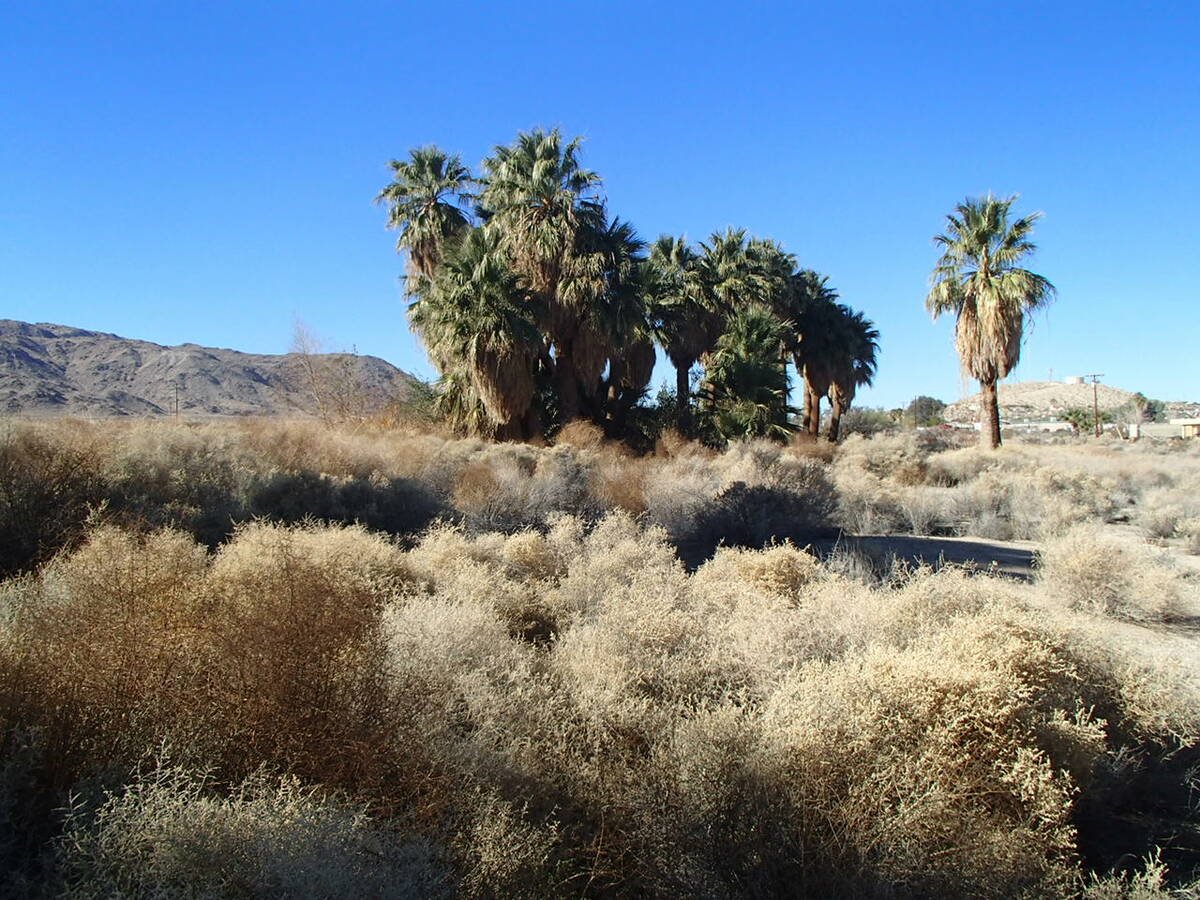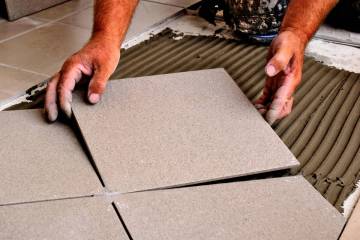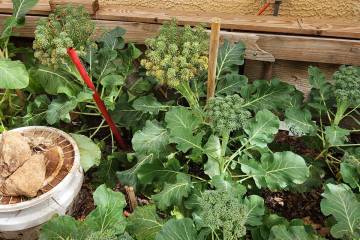Desert fan is easiest palm to grow in Las Vegas
Probably the easiest palm to grow in our area that can be started from seed is called the California or desert fan palm. It is considered a native because it’s commonly found in the desert but only near water.
Palms in general require water nearby, so they are always found near bodies of water. For this reason, I like to call palms “oasis plants.” It’s a common mistake to surround them with rock and no water in sight.
This palm, unlike the date palm with separate male and female trees, has both male and female flowers on the same tree. This means fruit can be produced on any California fan palm. In other words, the so-called California fan palm is monoecious, but date palms are not.
California and Mexican fan palms both rely on wind and insects for pollination and fruit set. The fruit from these palms was collected and transported to different locations by Native Americans and wild animals.
It was thought that the California or desert fan palm, unlike the Mexican fan palm, was self-pruning because it had such a clean trunk. But if we look at this desert palm in its wild or native ranges there is a mixture of palms with and without this frond skirt hanging beneath the canopy.
It’s true that some of these desert palms may self-prune while others don’t. It’s also true that people in the past have burned these skirts to easily harvest the fruit and control vermin. So just because it’s a California or desert fan palm doesn’t mean it will drop its fronds.
California and Mexican fan palms are easily confused. Adding to the confusion, both fan palms hybridize among themselves if they grow close enough together. A hybrid of these two, called the filibusta palm, is marketed in the nursery trade as the perfect landscape palm. We’ll see. Hybrids of these two palms are quite common wherever they grow close together, flower at the same time and produce fruit.
Your eyes won’t lie. If the young palm that you buy has a fat base, it’s not going to get skinnier over time. Because they hybridize easily it is not a safe bet to say that one has a skinny trunk and the other a fat trunk or that one self-prunes and the one next to it doesn’t.
Q: Now that the temperatures have cooled off a bit, is it safe to plant?
A: I would wait and make sure that the approximate weekly maximum and minimum temperatures have dropped before I planted. Maximum air temperatures should average no more than about 95 degrees with minimum temperatures no lower than about 50 degrees. Remember, in the hot desert, plant into a wet hole and use amended soil.
Historically, the end of September or the first part of October is a safe bet to start fall planting. Fall planting should wrap up around Dec. 1 for best results.
Planting outside of this temperature range will work, but the risk of having problems is a little higher. Air temperatures are not very predictable. Look at your weather app on your phone and pay attention to the high and low temperatures for the next 10 days.
Q: I have been struggling with my fruit trees this entire year. My lawn guy gave me a bottle of Liquinox Iron &Zinc this past week and told me to use it on a small Gala apple tree because the leaves were yellowing. He was hoping the liquid would “green” it up. I did not yet apply it because I think the temperature is still too hot. What should I do?
A: He’s right — if the yellowing is caused by a lack of iron or zinc. But now is the wrong time of year for a soil application.
Reading the label, it says you can apply it to the soil or spray on the leaves. This is a bottle of liquid iron and zinc chelates intended for yellowing plants. At this time of the year, it should be sprayed on the leaves, not applied to the soil.
If you want to apply it to the leaves now, wait for the air temperatures to cool off into the low to mid-90s during the day. If the leaf spray calls for a dilution with water, use distilled water.
Our tap water is too alkaline (high pH) for this product. Distilled water has a pH near neutral and these chelates work best at that pH.
Add about 1 tablespoon of liquid dishwashing detergent per gallon of spray mix. Use a spray bottle and spray it on the leaves until you see it start to roll off the leaves. Then spray another yellow area. Spray the entire tree about three or four days apart until you get the green you want.
Personally, I would save it and apply it to the soil surrounding the fruit tree next February. You have finished harvesting apples by now so the fruit gaining better size is not an issue.
Soil applications are much more effective because that’s where the plant roots are located. Follow the label directions, but use distilled water if it calls for a dilution. Iron and zinc applications are much more effective at that time of year when applied to the soil.
Q: When I make hard-boiled eggs I recycle and use the water and the eggshells to fertilize my plants. Is this beneficial or am I wasting my time?
A: You are never wasting your time by recycling eggshells. Just make sure the eggshells are ground up as small as possible. Use a kitchen blender with about a cup of water or use the water from hard boiling the eggs. Smaller particles of eggshells will make calcium in the eggshells more available to the plants than big eggshells.
While you are at it, add some other scraps, including coffee grounds, tea leaves and vegetable peelings, before you start blending.
Q: I subscribed to your blog, Xtremehorticulture of the Desert, several years ago. I used to get notifications regarding new posts every two weeks. I have not heard anything for quite some time. Is it still active?
A: I still post on my blog regularly but no longer send notices to my subscribers. The blog allows me to explain more and post more pictures than I have space for in my newspaper articles. There is no advertising on my blog. I don’t do it for money. I do it because it’s fun.
I also maintain a podcast, “Desert Horticulture,” where I explain topics that listeners who live and garden in the desert might find interesting. The podcasts are free to download on many different listening sites, including Buzzsprout, Spotify, iTunes, Google Play and Apple. Download them to your phone, computer or other device, and I hope you benefit from them.
Q: I am saving a sumac for a friend who lives in North Las Vegas. Please give us your tips to ensure the least stressful action for the tree when I give it to her. My friend leaves for the entire summer so the sumac needs a good head start this fall and winter.
A: Transfer it from the ground into a 1- or 5-gallon nursery container (we used to use large coffee cans with holes in the bottom for drainage) when it is only a few inches tall. Container-grown plants are easier to manage and plant later.
Along with the plant, remove as many of the roots as possible. If there is a sizable loss of roots with the transfer, remove one-third of the top of the plant to compensate for the root loss.
Wash the native soil from the roots before planting in the container. A sharp dividing line between different soils causes a discontinuity in water drainage and root growth. Without kinking the roots, plant it in the container using potting soil so the roots are as straight and feathered out as much as possible.
Leave about 1 inch of headspace at the top of the container for watering. Having straight roots when moving it from the ground or between containers helps prevent girdling or circling roots later. Fertilize it lightly each month it is actively growing, water daily, and make sure it gets at least eight hours of sunlight each day.
When the plant has doubled in size, move it into the next sized container. This is called “bumping it up.” Container or pot sizes should be progressively larger each time it’s bumped up.
Don’t bump it up to a much larger container. It won’t work well. Push its new growth with daily watering, light, and monthly light applications of fertilizer.
Prune it so that it has good tree structure when it is young. The top of the tree should have two-thirds top to one-third trunk. When planting it into the ground, put a doughnut around the planting hole about 4 inches tall so that it can be watered efficiently. Fertilize the tree once a year in the early spring.
Bob Morris is a horticulture expert and professor emeritus of UNLV. Visit his blog at xtremehorticulture.blogspot.com. Send questions to Extremehort@aol.com.























